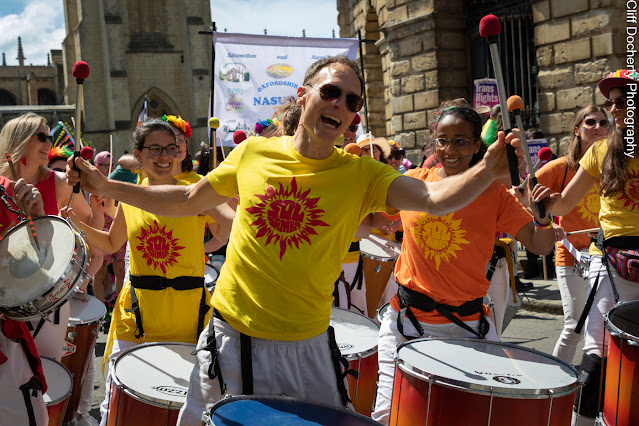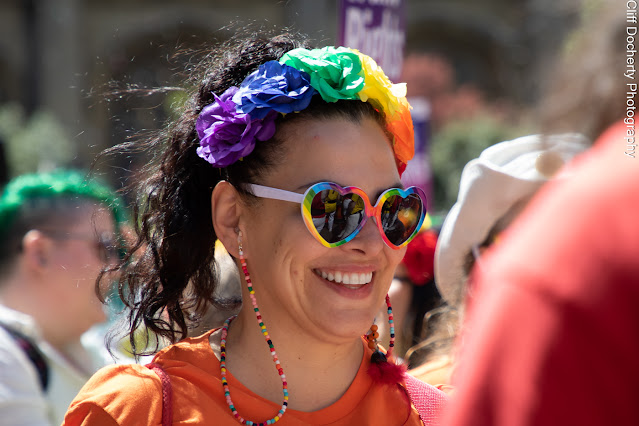A fairly regular gig for me in recent years has been to be one of the official event photographers for Oxford Pride's big day, and this year was no exception. What was exceptional though was some major upgrades to my shooting kit and a place in the photo pit at the festival stage with an access all areas media wristband, which meant I could really get up close and personal with the performers on stage, but first there was the small matter of the march.
Anyone can shoot a march but shooting a match well is harder than it seems and boy, its hard on the knees, the back and the lungs, not to mention the tonsils from all the shouting over the hullaballoo. Why is is it hard? Because you'll be running to the front of the march, dropping to the back, diving into the middle, back to the front, on your knees, on your toes, moving fast so you're not in people's way. Its exhausting, My throat was sore as heck the next day, so much so I thought I was coming down with a cold, but it was just voice strain.
So, what do you have to consider if you want to shoot a colourful Pride march, or for that matter any kind of march which might be memorable for all manner of reasons, particularly in these days when our rights to protest or make our point in public are being scaled back. Well the first thing is the law, above all. Less of an issue at a Pride march where its all about feeling safe in numbers and sending a positive and inclusive message, but we've seen random people arrested by mistake for being in proximity including journalists, so be aware of what you're shooting and any police who may be feeling jumpy. Most are positive and professional when you find them in positive situations bit if your march subject is contentious it pays to be aware of your operating environment.
The next thing is to get there early. Some of the best shots can be obtained before things get chaotic, during the time when people are assembling, socialising, linking up with their peers and fellow travellers before setting off on their route.
If possible have a couple of camera bodies to shoot with rather than be changing lenses and missing shots. Its a good reason not to trade in your old camera when you upgrade. It means you have a spare for these kind of fast moving events, one with a wide angle zoom and one with a telephoto zoom for getting those candid shots into the crowd or for isolating individuals in the melee.
When people are reasonably still try shooting with an open aperture for shallow depth of field so that you separate people from the general blob of what's going on, unless you're going for a crowd shot, but once they're moving you will probably want to head for 250th of a second or faster to avoid shake and blur, though a little movement adds to the sense of the march. Avoid shooting on auto or program because the camera invariably picks some middling setting that's unsatisfying from either a depth of field point of view or a motion blur perspective.
Apart from close ups, some of the interesting shots you can try include low, wide shots as the crowds hit a bend in the road, standing in the path of an oncoming group, shooting wide and getting a banner shot, getting police or stewards to pose with brightly or provocatively dressed marchers, pick out animals that people have brought along - there's always an interesting dog that the owners have dressed up in the spirit of the occasion.
If, like at Pride, the march moves on to an event taking place on stage, you may not be able to get too close unless you have some kind of media pass, but if you have a telephoto lens, again beware of auto metering. Always use the spot metering function on the speaker or performer's face to compensate for spotlighting, particularly as dusk falls. This will help avoid hot spots and burnout in your images. And, if you are near the speaker stack, protect your hearing. Those bad mommas are incredibly powerful and will bust your hearing for good if you're too close, which is why the performers in my pictures have earplugs in. Not all jobbing musicians can afford those state of the art monitors that pop in the ear and feed the music to them at safe sound levels. They have to rely on old fashioned monitor speakers pointing at them blasting aircraft engine level sound at them, so do what they do, and protect your hearing.
And lastly, remember to have fun. Last Saturday was truly magical for me and it was the best Pride shoot so far. Thanks to the train strike I had to leave by 6 to get back to London but it was a fabulous day which raised a lot of money for local good causes, and I captured some of my best performance pics ever while seeing some amazing young musicians give spellbinding performances. What's not to like? Happy Pride Month 🙂




Comments
Post a Comment